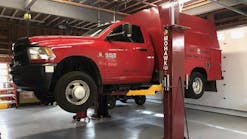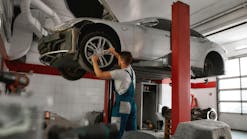Fatal accident should put shop safety on our agenda
A tragedy like the accident that took an automotive technician's life in August in all likelihood was an unusual circumstance.
According to the Blue Springs, Mo. police, three men were trying to relocate a four-post lift by dragging it using two cars. After dragging the lift a certain distance, the men stopped to take a break. The lift then fell on and killed one of the men standing near one of the vertical posts.
The tragedy can be blamed on the failure to follow accepted procedure, such as enlisting a professional service company to properly disassemble and reinstall the lift. No doubt the perception was that a few dollars and some time were being saved.
At this point in the investigation there are many unknowns. It is not known if the lift's manual covered relocation since most lifts are intended for permanent installation. It is not known if the lift was certified for conformity to the current American National Standard under the Automotive Lift Institute's independent, third-party product certification program. It is not known if the lift was manufactured by a company that doesn't bother with certification. It is not known if the employer had ever been subject to an Occupational Safety and Health Administration (OSHA) inspection. Missouri does not operate a state OSHA program. The OSHA program is administered in Missouri by federal OSHA.
These details won't be known until OSHA completes its investigation, which the agency expects could take six months.
Isolated incident? Doesn't matter
Isolated incident or not, safety training is far from perfect in automotive service shops. While training won't stop some people from ignoring their training or not using common sense, it does make a difference in the overall level of safety.
The unfortunate death in Blue Springs, Mo. gives reason to consider the state of repair shop safety.
Auto repair is changing as new features are added to cars and more sophisticated tools are introduced. Shops are dealing with more electric and air-powered equipment, more powerful tools and more and different chemicals. In addition, the introduction of electric vehicles ushers in yet a whole new set of safety concerns.
Most training in automotive repair shops focuses on the vehicles themselves, such as body work, suspensions, brakes, engines and transmissions. Little time or effort is expended on shop safety and the use of the sometimes complex repair tools themselves.
Are safety rules sufficient?
OSHA rules address some aspects of automotive shop safety. OSHA does suggest reliance upon manufacturer instructions, listing of electrical equipment, handling of dangerous chemicals and fluids, machine guarding and asbestos found in brake pads, for example. But OSHA does not address specific shop tools.
The Automotive Lift Institute (ALI), an organization of lift manufacturers, has taken a proactive role in vehicle lift safety. ALI has worked with OSHA to make shops aware of safe practices through OSHA's local emphasis programs.
Are safety rules comprehensive enough, given the increasing power of today's equipment? Is enforcement sufficient to prevent future accidents?
Bob Redding, Washington D.C. representative for the Automotive Service Association, thinks technician licensing programs administered by the states are the most practical way to improve safety training.
Training and licensing won't prevent accidents when people don't use common sense, as may have been the case in Blue Springs, Mo.
Nevertheless, the tragic incident should put shop safety on the agenda for the upcoming SEMA and AAPEX trade association meetings.
Repair shops exist to maintain vehicles in safe, operating condition. To provide this all-important service, shops must operate efficiently so they can remain in business and continue serving customers. But efficiency does not and should not negate safety. The definition of "efficiency" in my dictionary reads: "The state or quality of being efficient; competency in performance."


